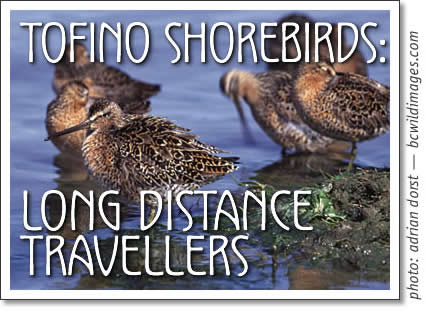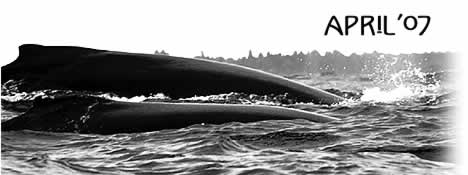
Tofino shorebirds: The Long Distance Travellers
by Adrian Dorst, Tofino

It's that time of year again. April is the month when shorebirds once again begin arriving in Clayoquot Sound from their wintering grounds to the south. Very slowly at first, with just a few individuals showing up early in the month, the trickle becomes a torrent of birds by the time April comes to a close. A few years ago, I watched in amazement as upwards of 50,000 Western Sandpipers took to the air at once. From where I stood, nearly a mile away, the mass of rising birds, accentuated by the green forest of Meares Island, looked like white confetti, blown up by the wind.Shorebirds, also known as waders, are comprised of several families of birds, not necessarily closely related to one another. Sandpipers are by far the largest group and vary in size from the tiny Least Sandpiper, which would fit easily in the palm of your hand, to the Marbled Godwit and Long-billed Curlew, both of which stand well over a foot high. Plovers form the second largest group. All members of this family have short bills, which forces them to lean far forward when feeding. This makes them easily distinguishable from sandpipers on the beach, even from a long distance away. Despite their appearance and ecological niche, some authorities now believe that plovers may be more closely related to gulls than to sandpipers. Oystercatchers and Avocets are two other families that make up the shorebird group. While we have Black Oystercatchers in our area, Avocets show up here only as very rare vagrants.
Shorebirds are long distance travellers for very good reason. The vast frozen north country, while entirely inhospitable to shorebirds in winter, becomes a rich feeding ground during the brief summer months. Then, the long summer days provide an abundance of food on which to raise their young. Immediately after the chicks are fending for themselves, which can be as early as mid-June, the adult birds begin their long journey back to their wintering grounds, to be followed a week or two later by their young. How, one wonders, do young Western Sandpipers, without the benefit of experience or the guidance of their elders, or gps, manage to find that beach in Ecuador, the very same beach to which their parents have travelled? Apparently they are pre-programmed, but exactly how this works remains a mystery.
Not all shorebirds breed in the arctic. Some breed near wetlands found in the taiga, or boreal forest, others near prairie potholes and sloughs. The Semipalmated Plover nests on beaches as far south as Haida Gwaii. The Kildeer, another plover, nests throughout much of North America on farm fields and airports, including our own. And, of course, the Black Oystercatcher nests on rocky islands along our coastline. Because of our temperate climate and the abundance of food found in the intertidal zone, oystercatchers need not migrate to the south but remain here year round. Most other species, however, are forced to make the long journey south in order to survive. The journey made by some is truly remarkable.
Take the case of the Bristle-thighed Curlew. This bird, with its long bill curved downwards is nearly indistinguishable from our Whimbrel. Its migration path, however, is very different. Each summer these birds depart western Alaska for islands in the south seas, travelling thousands of miles over the waters of the Pacific Ocean. Somehow they manage to find their winter home, a mere pin-prick in the vast ocean.
If the flight of the Bristle-thighed Curlew is amazing, that of the Bar-tailed Godwit is truly astonishing. Much as an air liner has to fuel up before a flight, so the godwits that nest in western Alaska first have to binge on rich food in order to pile on the fat reserves for the long flight to their winter home. This may exceed 50% of their total body weight. When ready, these birds depart Alaska and fly non-stop to New Zealand - a distance of nearly 10,000 kilometres. I suspect that if physicists were to crunch the numbers, this feat would be deemed impossible.
In Tofino, 43 different shorebird species have been recorded over the years. Of those, 32 species occur more or less regularly and 20 can be considered as being reasonably common. Abundance varies greatly. Twelve to 20 Greater Yellowlegs seen together, for example, represents a good sighting, and seeing more than a dozen Red Knots in a flock would be a surprise. Long-billed Dowitchers can be expected only occasionally, and then usually around fresh water. The Short-billed Dowitcher, on the other hand, for a very brief period, can be abundant, with numbers that may exceed 6,000 in a single flock.
Of all our shorebirds, the Western Sandpiper is by far the most abundant. While a flock of 50,000 birds sounds impressive, consider that in the Fraser River delta near Vancouver, Western Sandpipers are measured in the hundreds of thousands. In the Copper River Delta of Alaska, nearly the entire population convenes, with birds measured in the millions. The total population of Western Sandpipers is in the neighbourhood of 3.5 to 4 million birds, down from 6 million in the 1970s. It seems likely that environmental factors have played a role in reducing numbers.
The Whimbrel, a large shorebird with a down-curved beak, occurs here regularly in numbers that often exceed 100, but rarely 200 birds. They stop here to replenish their fat stores by feeding on Ghost Shrimp that live in the mud. Nowhere else in bc do these birds congregate in any significant numbers, underlining once again, the importance of these rich mudflats. Similarly, Tofino is the most significant stopover area for the even larger Marbled Godwit. These birds with their long, slightly upturned beak, nest on the Great Plains, but have a small, disjunct population in Alaska. With global warming likely to work in its favour there, we may well see larger numbers of these striking birds here in future. Indeed, this seems to be happening already. Prior to 1976, only 20 individuals had ever been reported, with only one of those in spring. Now, we see 50 to 100 birds a year.
One of the exciting aspects of bird-watching is the always present possibility of finding the unexpected - a bird that has strayed from its normal range. And so birders look for and occasionally find, a rare Snowy Plover from south of the 49th, among its cousins, the Semi-palmated Plovers that cover Chesterman and Long Beach in May. Or they may find a Long-billed Curlew that is much too far west among the Whimbrels. Once I checked the mudflats at dusk and was astonished to find 3 Avocets from the prairies of Alberta, resting with their heads under their wings. Unfortunately, they had already moved on by next morning. And on two successive springs, a Bar-tailed Godwit from Asia (and western Alaska), in full breeding plumage, made an appearance.
But oftentimes it is the more common events that are thrilling, such as a Peregrine Falcon or a Merlin zooming in out of the sun and seeing bedlam ensue among 10,000 birds as they rise as one, then whirl and dodge, the sound of 20,000 wings clearly audible. Or we watch as 20 Marbled Godwits sail in, and land gracefully on the mudflats, their ruddy feathered forms glowing in the evening sun.
The best period for viewing is generally the last week in April, and first two weeks in May. This varies somewhat from year to year. The bulk of the Western Sandpipers may move through in less than a week, normally around the end of the month or the first few days in May. On the mudflats it's a good idea to arrive an hour or so before high tide or a half hour after the tide begins to ebb. If it happens that you don't find much, try again an hour later. Conditions can change very quickly. And on the beach, please, please give the birds plenty of rooms and keep your dog on a leash.
Happy birding.
Adrian Dorst is a Tofino nature photographer, carver, and birdwatching guide. Visit Adrian's websites at www.adriandorst.com and at www.bcwildimages.com
Tofino Time April 2007
- Tofino Time turns five!
- Tofino Time turns five! - Our thanks to Tofino
- Tofino tides: Tide table for Tofino April 2007
- Tofino Fishing outlook for 2007
- Tofino recipe: Matthias Conradi's Potato & Squid salad
- Tofino concerts: Music in April 2007
- Tofino shorebirds: The long distance travellers
- Tofino earth day: April 22, 2007
- 10th Annual Tofino Shorebird festival - Calendar
- Tofino artist George Hunt Junior
- Tofino artist Elaine Savoie
- Tofino Horoscope for April 2007
- Tofino history: John Meares and Meares Island
- Tofino Timeless - Chapter Four
- Tofino gardening in April 2007
- Events in Tofino
- Community Directory: Goods & Services in Tofino
tofino | tofino time | activities | accommodation | events | directory
maps | travel | food | art & artists | photos | horoscope | tides
search | magazine | issues | articles | advertising | contact us
hosted in tofino by tofino.net & studio tofino
© 2002-2014 copyright Tofino Time Magazine in Tofino Canada

Tofino shorebirds travel some of the longest distances in any bird migration. Tofino's mudflats make Tofino a good resting place for shore birds and offer great opportunity for bird watching in Tofino,
